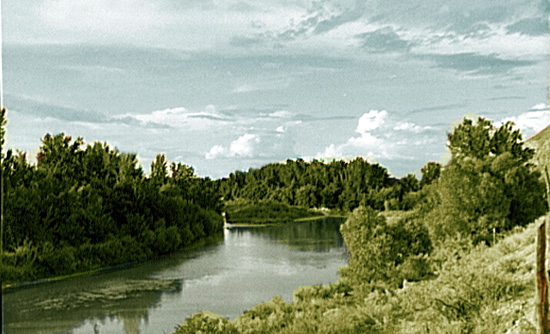
Tongue River near Briney, Montana.
As noted by Andy Adams, a branch of the Texas Trail leading to Musselshell followed the Tongue.
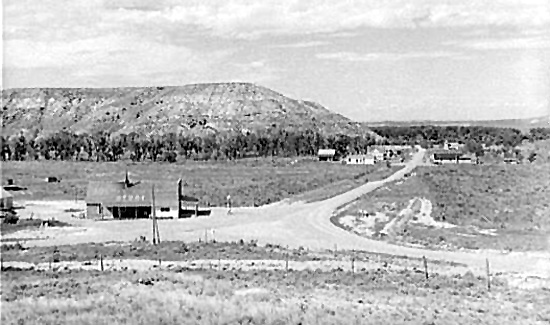
Distant View of Briney, Montana, 1939.
When the routine week's work of tending to eqipment, animals and other things required of
a stock ranch was done, the cowboys might ride into Birney. Birney was, however, not a resort town or one
famous for its night life. There was a two-room school, a church, astore, a ranch supply store which also housed the post office, a saloon, and the \
Corral dance hall. The Corral, was not a dance hall in the usual sense, more of a community center where Saturday night dances were held.
The saloon was one in which the cowboys might simply relax and socialize.
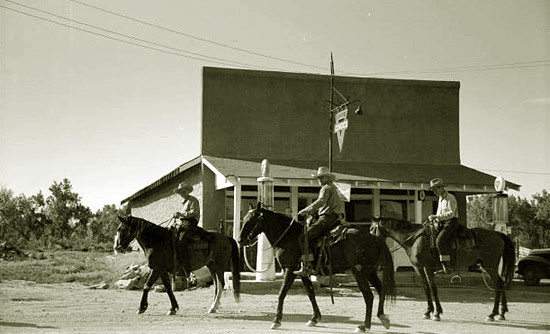
Quarter Circle U cowboys passing store in Birney, 1941.
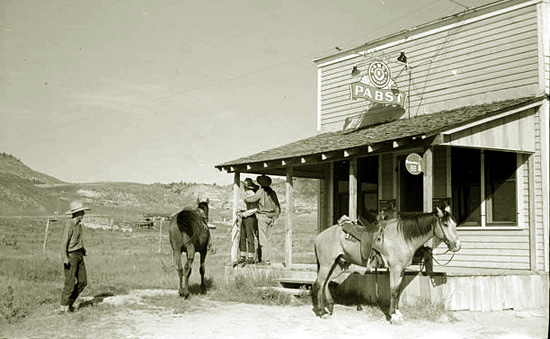
Saloon, Birney, Montana, 1941.
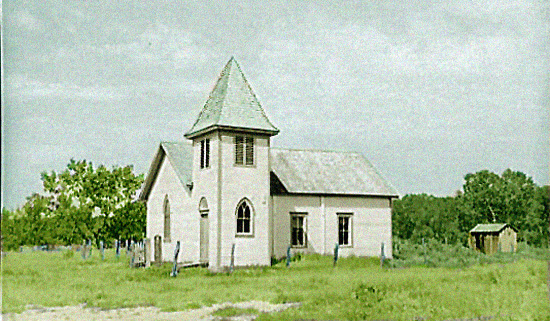
Church, Birney, Montana, 1941.
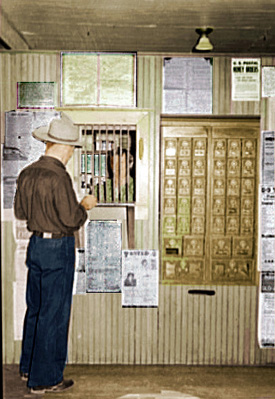 . . . . . .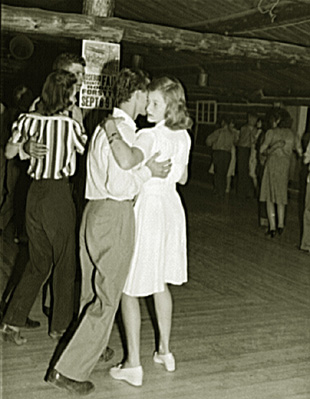
Left: Birney, Montana, Post Office, 1941, Right, Saturday Night Dance at the
Corral Dance Hall, August, 1941.
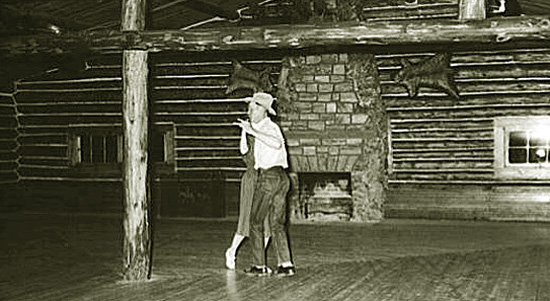
Corral Dance Hall, Birney, Montana, 1941.
The Corral burned down. As of a few years prior to this writing (2011), all that remained was the fire place, chimney and
foundation stones.
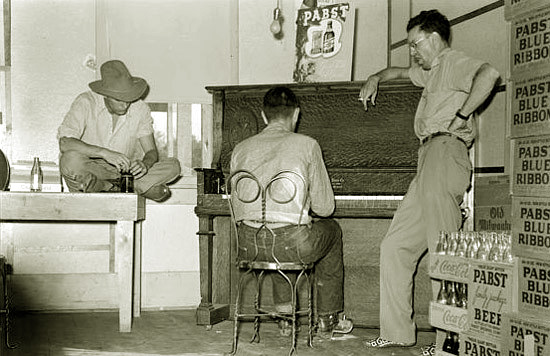
Playing the piano in the Saloon, Birney, Montana, 1941..
By the time of the above photos, the War in Europe was raging. In only a few months, the United States would
join in. The war resulted in many dude ranch operations being discontinued for the "duration." Advertising by railroads for
dude ranches was discontinued. Gasoline was rationed so that dude ranches at a distance from a railroad were severly handicapped. Cowboys enlisted.
Some 16 enlistees from Rosebud County failed to return at the end of the war, killed or missing in action. Following the war,
resort dude ranches met a pent up demand and had their best years ever but increasing governmental regulations made hosting of
dudes on stock ranches less and less economically viable. While exemptions from many regulations were enacted, they were narrowly implemented so as to apply
only to purely agricultural work. As just one example, operation of a cook camp for the sole purpose of feeding cowboys working
exclusively on the ranch may be exempt from provisions of the Fair Labor Standards Act, but if the camp feeds guests, it will no
longer be exempt.
An exemption is in the law for those engaged in the production of live stock on the "range." It is narrowly interpreted. 29 Code of Federal
Regulations, Section 780 provides in part:
Sec. 780.329 Exempt work.
(a) The standard that must be used to determine whether the
individual employee is exempt is that his primary duty must be the range
production of livestock and that this duty necessitates his constant
attendance on the range, on a standby basis, for such periods of time so
as to make the computation of hours worked extremely difficult. The fact
that an employee generally returns to his place of residence at the end
of each day would not affect the application of the exemption.
(b) Thus, exempt work must be performed away from the
``headquarters.'' The headquarters is not, however, to be confused with
the ``headquarters ranch.'' The term headquarters has reference to the
place for the transaction of the business of the ranch (administrative
center), as distinguished from buildings or lots used for convenience
elsewhere. It is a particular location for the discharge of the
management duties. Accordingly, the term ``headquarters'' would not
embrace large acreage, but only the ranchhouse, barns, sheds, pen,
bunkhouse, cookhouse, and other buildings in the vicinity. The balance
of the ``headquarters ranch'' would be the ``range.''
(c) Furthermore, the legislative history indicates that this
exemption was not intended to apply to feed lots or to any area where
the stock involved would be near headquarters. Its sponsors stated that
the exemption would apply only to those employees principally engaged in
activities which require constant attendance on a standby basis, away
from headquarters, such as herding, where the computation of hours
worked would be extremely difficult. Such constant surveillance of
livestock that graze and reproduce on range lands is necessary to see
that the animals receive adequate care, water, salt, minerals, feed
supplements, and protection from insects, parasites, disease, predators,
adverse weather, etc.
(d) The man-days of labor of employees principally engaged in the
range production of livestock, even though the employees are exempt from
the wage and hour requirements of the Act, are included in the
employer's man-day count for purposes of application of section
13(a)(6)(A). Thus, if a cattle rancher in a particular calendar quarter
uses 200 man-days of such range production labor and 400 man-days of
agricultural labor performed by individuals not so engaged, he is
required to pay the minimum wage to the latter employees in the
following year.
Thus, many of the old family owned stock ranches have discontinued hosting dudes. Dude ranching has instead
gravitated to "resort ranches" or to motels and hotels which have stables in conjunction.
On the Tongue, a constant battle continues between stockgrowers and environmentalists. The writer recently (2011) attended a conference in Florida relating to
farming and ranching. The current buzz word in
environmental circles is "agri-biodiversity." The purpose of the "biodiversity" is to protect individual species even down to
the landscape level. One county in that state has various listed species entitled to protection. These include the Sand Cockroach, the Scrub Jay Louse, the
Sandcrane Lice and the Slave-making Ant. See Boyes, Patrice, "Agricultural and Natural Resources: Toward a New Balance of Power." Boyes, in her comments,
noted as a difficulty facing family ranches, the constrant moving target in getting approvals. By the time approval is sought for a plan of
development, the rules have changed and it is necessary to go back to the drawing board. In Wyoming livestock grazing, roads, and wind farms have been identified as
threats to the sage grouse. Discussed elsewhere on this website is the Prebble's Meadow Jumping Mouse. The net impact has been, according to Margaret Rosso Grossman,
Diversification of Farm Enterprises in the United States: Legal Incentives and Legal Obstacles, "The majority of farms in the U.S. do not produce enough income from
agriculture to support the farm family." She notes that "recent data indicates that off-farm employment provides nearly
80 percent of family household income." Only on the largest 8% does the income from the farm exceed off-farm income.
Thus, the future of the smaller family ranch is becoming itself an endangered species.
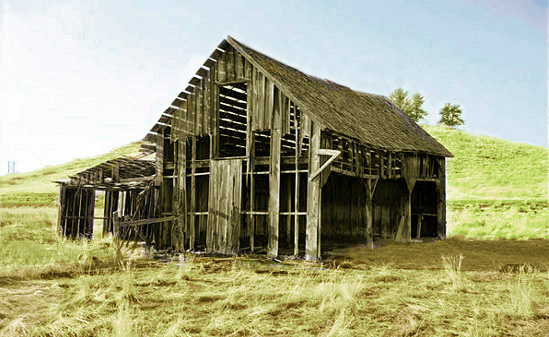
Abandoned barn on the old Doc Taylor Ranch, Rosebud County, Montana, 1971.
The Taylor Brothers, Levi "Doc" Taylor and Harry Taylor with their wives, acquired 942 acres about 40 miles north of Birney between 1912 and 1920. During World War II, the family moved away.
Doc's widow moved to Cody and his son, Linc moved to Miles City.
The Quarter Circle U still belongs to the descendants of its original founders. It currently holds
about 8,400 acres. Unfortunately, it does not hold title to all of the minerals. This has involved it, and other
ranchers in the Birney area in a fight over the conflict between the ability to ranch the property and the
rights of the mineral holders. Additionally, the issue of water rights has again come to the fore. Water is
essential to ranch operations but is also required for the mining.
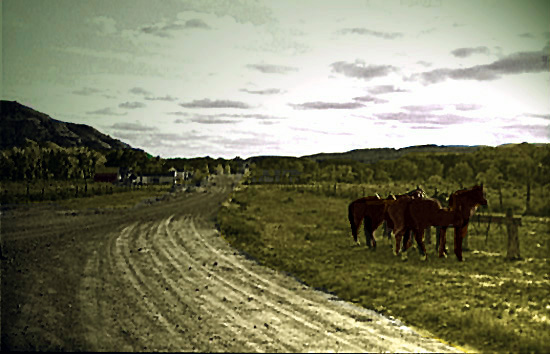
The sun setting over Quarter Circle horses at the Saloon, Birney, Montana, August, 1941.
Music this page: Home on the Range, courtesy of Horse Creek Cowboy.
Home on the Range is typically associated with the American West and is the State Song of Kansas. The English words as
printed below represent the generally accepted current lyrics, although the lyrics have changed over the years. The song
has travelled to the northeast. In 2012, the writer travelled to Iceland where he viewed at a horse farm, among other things,
a demonstration of the five gaits of the Icelandic horse.. The Islandic horse is stockier than American
quarter horses and naturally has five gaits. In addition to the normal walk, trot, canter, and gallup, there is a gait known as the
tölt, fast and smooth. In the demonstration, one of the wranglers was able to carry a full mug of beer twice around the
arena at full speed without spilling a drop. Following the demonstration, the group had kaffi and Islandic cakes. Two of the
riders then broke out into song. While the Icelandic lyrics were unfamiliar, the tune was very familiar. Entitled Fram Í Heiðanna Ró, it
was "Home on the Range." To hear "Home on the Range" sung in Icelandic on U-Tube Click here (linked).
Dr. Higley, when the song was written about 1873, lived in a sod dugout very similar to those of
many early Icelandic sheepherders.
Original English Lyrics: Dr. Brewster M. Higley (1823–1911)
Music: Daniel E. Kelley (1845-1905)
Islander texti: Friðrik A. Friðriksson
|
HOME ON THE RANGE
Oh, give me a home where the buffalo roam
And the deer and the antelope play
Where seldom is heard a discouraging word
And the skies are not cloudy all day
Home, home on the range
Where the deer and the antelope play
Where seldom is heard a discouraging word
And the skies are not cloudy all day
How often at night when the heavens are bright
With the light from the glittering stars
Have I stood there amazed and asked as I gazed
If their glory exceeds that of ours
Home, home on the range
Where the deer and the antelope play
Where seldom is heard a discouraging word
And the skies are not cloudy all day
Where the air is so pure, the zephyrs so free
The breezes so balmy and light
That I would not exchange my home on the range
For all of the cities so bright
Home, home on the range
Where the deer and the antelope play
Where seldom is heard a discouraging word
And the skies are not cloudy all day
Oh, I love those wild flow'rs in this dear land of ours
The curlew, I love to hear scream
And I love the white rocks and the antelope flocks
That graze on the mountaintops green
Home, home on the range
Where the deer and the antelope play
Where seldom is heard a discouraging word
And the skies are not cloudy all day
|
FRAM Í HEIÐANNA RÓ
Fram í heiðanna ró
fann ég bólstað og bjó,
þar sem birkið og fjalldrapinn grær.
Þar er vistin mér góð,
aldrei heyrðist þar hnjóð,
Þar er himinninn víður og tær.
Heiðar bóli ég bý.
Þar sem birkið og fjalldrapinn grær.
Þar er vistin mér góð,
aldrei heyrðist þar hnjóð,
Þar er himinninn víður og tær.
Mörg hin steinhljóðu kvöld,
upp í stjarnanna fjöld
hef ég starað í spyrjandi þrá:
Skildi dýrðin í geim
bera' af dásemdum þeim,
sem vor draumfagri jarðheimur á?
Heiðar bóli ég bý.
Þar sem birkið og fjalldrapinn grær.
Mundi dýrðin í geim
bera' af Gdásemdum þeim,
sem vor draumfagri jarðheimur á?
Þetta loft er svo hreint.
Finnið þytmjúkan þey
- hve hann þyrlar upp anga úr mó.
Nei, ég vildi' ekki borgir
né blikandi torg
fyrir býlið í heiðanna ró.
Heiðar bóli ég bý.
Þar sem birkið og fjalldrapinn grær.
Nei, ég vildi' ekki borgir
né blikandi torg
fyrir býlið í heiðanna ró.
|
Next page: the Eaton Brothers' Ranch, the first dude ranch.
|